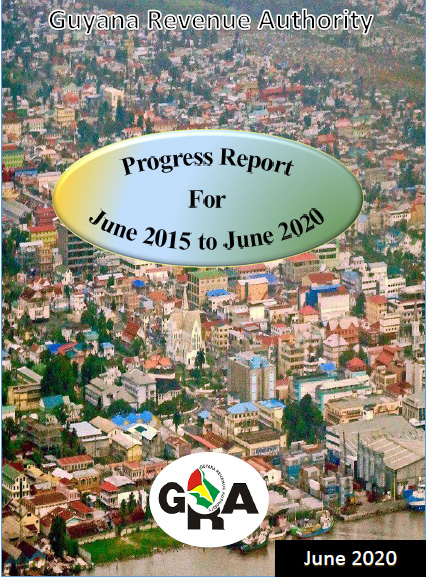In the preceding five years the Law Enforcement and Investigation Division (LEID) of the Guyana Revenue Authority (GRA) collected over $3 billion in revenue through monitoring and enforcement activities but despite its successes the tax body is currently monitoring several defaulting tax payers who cumulatively owe more than the same figure in unpaid taxes.
A draft report on the authority’s operations during the period June 2015 to June 2020, which has been seen by Sunday Stabroek, says that the significant increase in revenue was as a result of the implementation of several initiatives, measures and strategies, including the creation of a petroleum unit, intensified LEID operations at the wharves and regional locations, and the effective use of the division’s limited human and capital resources.
Sunday Stabroek understands that Commissioner-General Godfrey Statia began preparing the report as a handing over document following the March, 2020 elections. It is, however, not clear if it was ever completed.

The 158-page document explains that a Petroleum Unit was implemented in an attempt to mitigate the loss of revenue through fuel smuggling and tax evasion through under-invoicing. This unit alone was able in 2019 to aid in the collection of $600 million.
This unit was tasked with monitoring the reporting of all incoming and outgoing fuel vessels; monitoring of declarations made, inclusive of ship stores, by all importers of fuel to ensure that the information submitted to the Proper Officer is consistent with the requirements of the Customs Act and Standard Operating Procedures; and monitoring the submission of all monthly schedules of fuel consumption by the respective beneficiaries of tax exemptions and make appropriate recommendations within the defined time frame of those eligible under the tax credit system. The unit also conducted reviews and reconciliation of all fuel imports and created a database of all pertinent information which would be required for future transactions while conducting coordinated patrols within the 10 administrative regions of Guyana as well as spontaneous exercises to witness the offloading of petroleum products at the various bulk stations/ terminals among other duties.
This newspaper previously reported that following a probe into tax exemptions on fuel imports a sum of $606.9 million was paid to GRA by Sol Guyana on the 13,862,701 litres of gas oil which was imported, duly entered free of Excise Tax and was not delivered to Bosai companies to be utilised for the intended purpose.
GRA has recently made a $3.3 billion demand of Sol following a similar probe into its operations with relation to ExxonMobil. The authority is contending that Sol misused the Permits for Immediate Delivery (PID) system by commingling tax-exempted fuel with fuel not exempted or partially exempted so as to avoid paying taxes owed on the required basis. Specifically, it alleges that Sol in 2015 imported 6,320,410 litres of fuel for Exxon affiliate EEPGL but none of this fuel was uplifted by the oil company within the legally prescribed time period. In 2016, a total of 12,618,910 litres was imported for Exxon but only 3,591,380 was uplifted in the required time period, while in 2020 a total of 202,829,427 litres was imported and only 147,982,679 litres uplifted.
The fuel company has denied the allegations, stating that they were “false, highly misleading, and damaging.” The two entities are currently in talks to resolve the matter.
Other units within LEID which have made significant recoveries include the VAT Enforcement Unit (VEU), which collected revenue in excess of $260.88 million in 2019.
The unit, which was established in 2017 as a result of a directive from Statia, has increased the VAT registrant tax roll and works to ensure that VAT registrants remain in
compliance with the provisions of the VAT Act as well as to improve the VAT revenue through continuous monitoring.
VEU is currently equipped with six officers and since the commencement of its operation a total of 200 persons were mandatorily registered for VAT, 240 VAT packages and Demand Notices have been sent to taxpayers, and in excess of 256 referrals have been completed.
“The unit has successfully recovered revenue in excess of $260,878,209 as at December 31, 2019,” the report details.
Risk profiling of importers and exporters sought to prevent leakage in revenue mainly through false declarations made by importers. This measure was intensified in the period June to October, 2019, resulting in revenue recovery in excess of $116 million.
“This initiative has undoubtedly forced compliance by importers as well as officer of Customs, Excise and Trade Operations to exercise greater scrutiny of declarations of imported goods and be more prudent in carrying out their duties, particularly with respect to valuation and examination of goods,” the report says.
Exceeded targets
Overall revenue collected by LEID in the five-year period consistently exceeded revenue targets set for each year.
“From 2015 to 2016 revenue collected increased by 27.6%; from 2016 to 2017 revenue increased by 30.01%; from 2017 to 2018 there was an 85.06% increase in revenue collected and from 2018 to 2019 revenue increased by 92.3%… In 2019 LEID would have collected its highest revenue in the division’s history, which amount to $1, 242, 954, 223,” the report states.
Additionally, for the first time in its history, the LEID initiated court proceedings.
“From September 2017 LEID commenced initiating its own legal proceedings against offenders…fines were recovered in several matters and three persons were sentenced to one year in prison while another was sentenced to three years for dealing in un-customed goods and false declaration, respectively,” it notes.
The Legal Services Department (LSD), which previously dealt with such matters, focused its actions on legal proceedings for outstanding taxes under several sections of Guyana’s tax laws and were able to secure 164 judgments totaling $252.88 million via registration certificates. The certificates were issued under Section 101 of the Income Tax Act for the remittance of PAYE, Corporation, Income and Property taxes; Section 44 for Value Added Tax Act and Section 253 of the Customs Act. Each of the referenced sections allows the Commissioner-General to make out a certificate for sums owed for more than 30 days. Once submitted to the Registrar of the Supreme Court, these certificates have the same force and effect as a judgment for the State obtained in the High Court for a debt.
In addition to revenue garnered from judgments obtained, the LSD also collected revenue from matters that were settled departmentally through the execution of payment plans.
The revenues garnered through the monitoring of non-judgment matters amounted to a total of $275.42 million.
Despite these successes the Authority found it difficult to enforce some judgments and continues to monitor defaulters whose debts equal $3,785,911,063.
“Regardless of the efforts made by the Enforcement Officers, taxpayers continue to default in payments. In some instances, the business no longer exists and it is difficult to locate the owner, and even when the owner is found, and a commitment is made to pay, it is not complied with,” the report notes.
Constraints
It laments that in some cases, the business and the owners are separate individuals and hence it is almost impossible to levy against any existing property since the property is registered in the name of the owner and not in the name of the business.
“Another challenge is the unavailability of transport to execute service of court documents and to follow up on other enforcement activities,” the report adds.
The lack of proper transportation was identified a challenge for other units within GRA, including the eight units which comprise the Law Enforcement and Investigation Division (LEID).
According to the report, LEID was constrained by the lack of capital resources, including state of the art equipment such as closed circuit surveillance camera systems, drones (enhanced), better equipped patrol vessels, motor vehicles, and other specialized equipment which would significantly increase detection and interdiction of smuggled goods and increase collection of revenue.
The division was hampered by porous borders, lack of adequate staff and a lack of sufficient penalty in law to serve as deterrent.
“Some of the laws are outdated and may need to be amended to cope with the new methods of operations and investigations,” it advises.
Despite these constraints, LEID was able during the five year period to surpass its revenue goal in each year.






